Unit 5 Meeting our ancestor
- 格式:ppt
- 大小:1.36 MB
- 文档页数:16
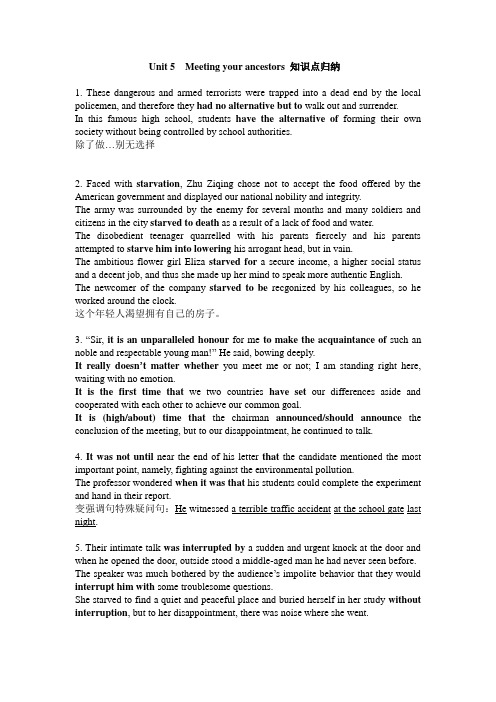
Unit 5 Meeting your ancestors 知识点归纳1. These dangerous and armed terrorists were trapped into a dead end by the local policemen, and therefore they had no alternative but to walk out and surrender.In this famous high school, students have the alternative of forming their own society without being controlled by school authorities.除了做…别无选择______________________ ____________________________ _______________________________ _________________________________2. Faced with starvation, Zhu Ziqing chose not to accept the food offered by the American government and displayed our national nobility and integrity.The army was surrounded by the enemy for several months and many soldiers and citizens in the city starved to death as a result of a lack of food and water.The disobedient teenager quarrelled with his parents fiercely and his parents attempted to starve him into lowering his arrogant head, but in vain.The ambitious flower girl Eliza starved for a secure income, a higher social status and a decent job, and thus she made up her mind to speak more authentic English. The newcomer of the company starved to be recgonized by his colleagues, so he worked around the clock.这个年轻人渴望拥有自己的房子。
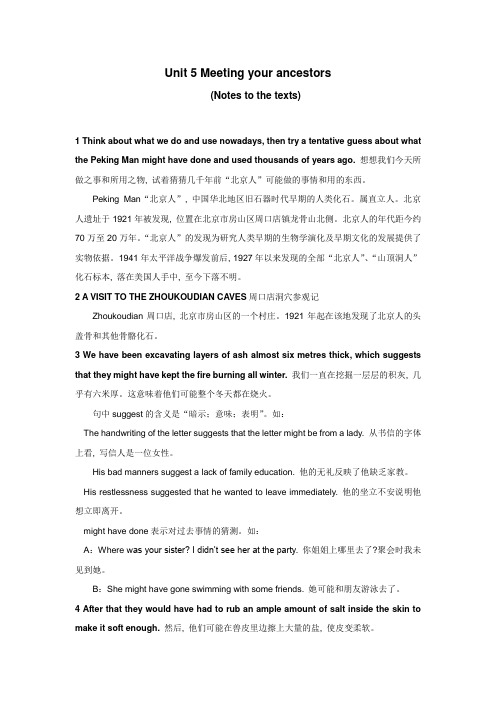
Unit 5 Meeting your ancestors(Notes to the texts)1 Think about what we do and use nowadays, then try a tentative guess about what the Peking Man might have done and used thousands of years ago. 想想我们今天所做之事和所用之物, 试着猜猜几千年前“北京人”可能做的事情和用的东西。
Peking Man“北京人”, 中国华北地区旧石器时代早期的人类化石。
属直立人。
北京人遗址于1921年被发现, 位置在北京市房山区周口店镇龙骨山北侧。
北京人的年代距今约70万至20万年。
“北京人”的发现为研究人类早期的生物学演化及早期文化的发展提供了实物依据。
1941年太平洋战争爆发前后, 1927年以来发现的全部“北京人”、“山顶洞人”化石标本, 落在美国人手中, 至今下落不明。
2 A VISIT TO THE ZHOUKOUDIAN CAVES周口店洞穴参观记Zhoukoudian周口店, 北京市房山区的一个村庄。
1921年起在该地发现了北京人的头盖骨和其他骨骼化石。
3 We have been excavating layers of ash almost six metres thick, which suggests that they might have kept the fire burning all winter. 我们一直在挖掘一层层的积灰, 几乎有六米厚。
这意味着他们可能整个冬天都在烧火。
句中suggest的含义是“暗示;意味;表明”。
如:The handwriting of the letter suggests that the letter might be from a lady. 从书信的字体上看, 写信人是一位女性。
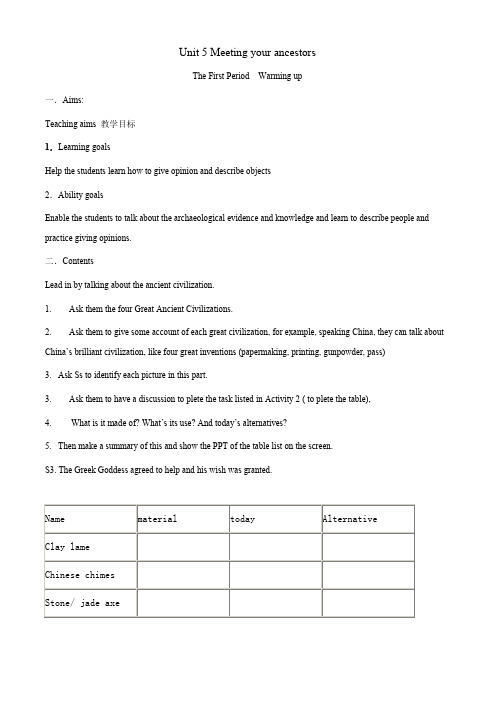
Unit 5 Meeting your ancestorsThe First Period Warming up一.Aims:Teaching aims 教学目标1.Learning goalsHelp the students learn how to give opinion and describe objects2.Ability goalsEnable the students to talk about the archaeological evidence and knowledge and learn to describe people and practice giving opinions.二.ContentsLead in by talking about the ancient civilization.1. Ask them the four Great Ancient Civilizations.2. Ask them to give some account of each great civilization, for example, speaking China, they can talk about China’s brilliant civilization, like four great inventions (papermaking, printing, gunpowder, pass)3. Ask Ss to identify each picture in this part.3. Ask them to have a discussion to plete the task listed in Activity 2 ( to plete the table),4. What is it made of? What’s its use? And today’s alternatives?5. Then make a summary of this and show the PPT of the table list on the screen.S3. The Greek Goddess agreed to help and his wish was granted.Name material today AlternativeClay lameChinese chimesStone/ jade axeDeath maskHomeworkAsk the students to find some information about Zhoukoudian.The Second Period Reading一.Aims:Teaching aims 教学目标1. Target language目标语言:重点词汇和短语archaeology, tentative, accuracy, excavate, interrupt, ornament, assume, regardless, sharpen, cut up, scrape, ample, primitive, preserve, bead, botany, botanical, analysis, specific, seashell, specifically2. Ability aims能力目标Enable the Ss to tell the differences between modern people and Peking man and learn how Peking man lived their lives.Content:Step I RevisionCheck the homework.The Ss will how their information about Zhoukoudian Caves in the following steps.Step II Lead in1. Ask the Ss to identify the picture in the pre-reading part. (skullcap)2. Ask Ss to assume what Peking man might have done and use thousands of years ago.3. Then by showing the table following to show whether their assumptions are right or wrong.Modern people Peking man AccuracyPlaces of living Modern architecture, which is huge, like boxeswith flat roofs, sharpcorners and glass wallsCaves Very accurateFurniture Beautiful furniture with lots of ornaments mostly made of wood or other special materialsNatural furniture made of stone orwoodAccurateEntertainment Watching TV, surfing the Internet and traveling Enjoy the nature or familyget-togetherInaccurateFood A good variety of cooked food, which tastesdeliciousNatural food, such as nuts and fruitsAccurateClothing Clothes made form special material, such as cotton and woodClothes made form animal skinsAccurateStep III Reading1. Play the tape once, and ask the Ss what they have learned about Zhoukoudian Caves2. Skimming (What is the text about? And three stages of the archaeologist’s part of the dialogue: An archeologist is showing a group of students from England around the Zhoukoudian Caves and telling them something bout the caves.)3. Scanning (Ask them to write down the three ways in which the life of early people differs from modern ones. Ask them to work in pairs and discuss the questions.Homes: Peking man lived in Zhoukoudian Caves of rocks and trees.Tools: They used needle that was made of bone sharpened stone tools and scraper made by stones.Dress: They wore clothes form animal skins and they also wore necklace made from seashells or animal teeth. 4. Careful readingStep IV Post-readingAsk Ss to fill in the chart on the life and habits of Peking man on page 37 and pare it with the list they made in the pre-reading. What differences are there?And then to clarify Ss’ difficult points in the text.Step V HomeworkWrite a brief introduction to the Zhoukoudian Cave.The Third Period Language Points一.Aims:Teaching aims 教学目标1.Ability aims能力目标Enable the students to use the Present Perfect Continuous tense.2. Learning ability aims 学能目标Help the students lean how to use the Present Perfect Continuous tense.Content 教学内容1. identify vt. 确认,识别,鉴别(1)~ sb. /sth. as sb./ sth.确认,证明某人/某物系某人/某物e.g. She identified the man as her attacker.(2)~ sth. with sth.认为某事物与另一事物等同e.g. One can’t ~ happiness with wealth.扩展:identification n. identification card 身份证2. alternative adj. 供选择的,其他的e.g. The way was blocked ,so we had to go by ~ road.这条路阻塞,我们只能走其他路。
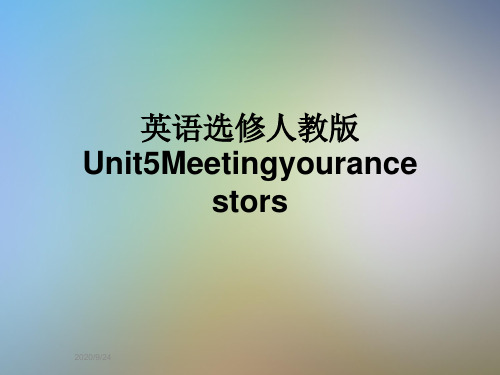
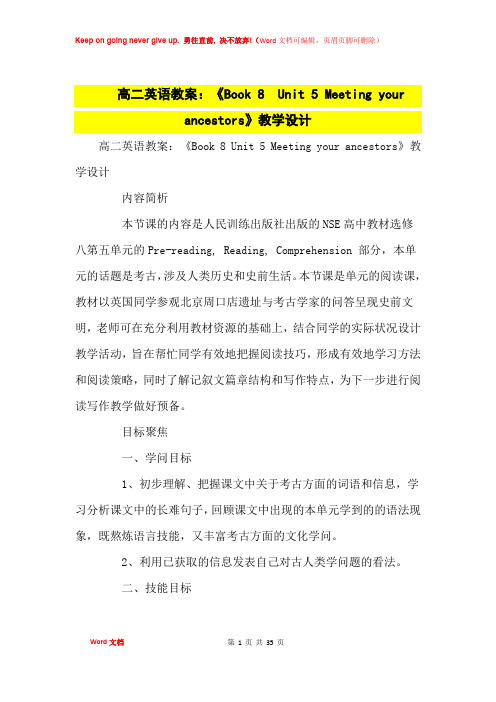
高二英语教案:《Book 8 Unit 5 Meeting yourancestors》教学设计高二英语教案:《Book 8 Unit 5 Meeting your ancestors》教学设计内容简析本节课的内容是人民训练出版社出版的NSE高中教材选修八第五单元的Pre-reading, Reading, Comprehension 部分,本单元的话题是考古,涉及人类历史和史前生活。
本节课是单元的阅读课,教材以英国同学参观北京周口店遗址与考古学家的问答呈现史前文明,老师可在充分利用教材资源的基础上,结合同学的实际状况设计教学活动,旨在帮忙同学有效地把握阅读技巧,形成有效地学习方法和阅读策略,同时了解记叙文篇章结构和写作特点,为下一步进行阅读写作教学做好预备。
目标聚焦一、学问目标1、初步理解、把握课文中关于考古方面的词语和信息,学习分析课文中的长难句子,回顾课文中出现的本单元学到的的语法现象,既熬炼语言技能,又丰富考古方面的文化学问。
2、利用已获取的信息发表自己对古人类学问题的看法。
二、技能目标1、能理解文章主旨大意,获取信息、处理信息、进行推理推断和表达的力量。
2、形成分析篇章结构的力量,提升规律思维力量3、学会总结该体裁特点。
三、策略目标1、通过图片和标题猜测文章内容;运用略读和找读策略快速获取信息,并能够精读文章获取信息和分析信息。
2、能利用上下文猜想生词词义。
(四)情感看法目标初步了解我们的祖先及考古学问;激发同学对考古学的爱好和欲望。
方法运用1、整体教学法2、体裁教学法3、导、读、练的教学模式学习操作流程Before class (课前自主学习,合作探究)Task 1 Vocabulary(词汇预习)Preview the new words of this text.【设计意图】通过预习词汇为下一步的阅读扫清生词障碍。
Task 2 Warming up(热身)Please look at the pictures on P37 (Warming Up---1) and fill in the chart below the pictures:【设计意图】通过图片激发同学爱好,引出本单元的话题, 为后面的阅读做铺垫,帮忙同学顺当完成阅读。
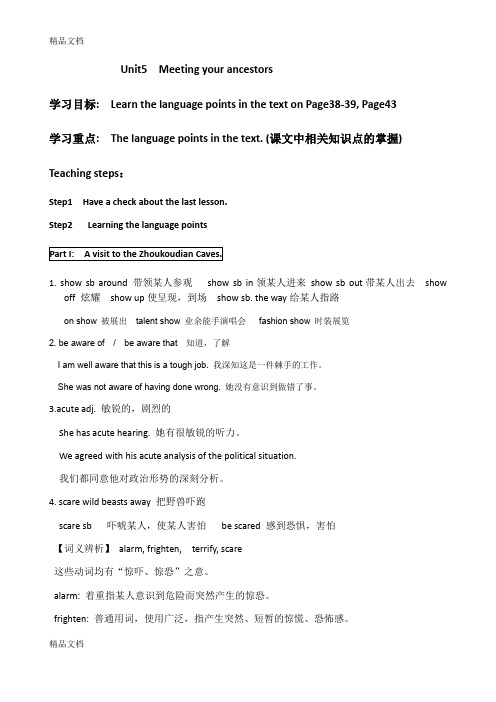
Unit5 Meeting your ancestors学习目标: Learn the language points in the text on Page38-39, Page43学习重点: The language points in the text. (课文中相关知识点的掌握) Teaching steps:Step1 Have a check about the last lesson.Step2 Learning the language points1. show sb around 带领某人参观show sb in领某人进来show sb out带某人出去showoff 炫耀show up使呈现,到场show sb. the way给某人指路on show 被展出talent show 业余能手演唱会fashion show 时装展览2. be aware of / be aware that 知道,了解I am well aware that this is a tough job. 我深知这是一件棘手的工作。
She was not aware of having done wrong. 她没有意识到做错了事。
3.acute adj. 敏锐的,剧烈的She has acute hearing. 她有很敏锐的听力。
We agreed with his acute analysis of the political situation.我们都同意他对政治形势的深刻分析。
4. scare wild beasts away 把野兽吓跑scare sb 吓唬某人,使某人害怕be scared 感到恐惧,害怕【词义辨析】alarm, frighten, terrify, scare这些动词均有“惊吓、惊恐”之意。
alarm: 着重指某人意识到危险而突然产生的惊恐。
frighten: 普通用词,使用广泛,指产生突然、短暂的惊慌、恐怖感。
Unit 5 Meeting your ancestorsThe 1st period Speaking1 Ability goalsEnable the students to talk about archaeological evidence and knowledge and learn to describe people and practice giving opinions2 learning ability goalsHelp the students learn how to give opinions and describe objects3 Teaching important & difficult pointsLearn to describe objects and give opinions4 Teaching methodsOral practice and cooperative learningStep 1 Warming –up page 37Guide the students to talking about the ancient civilizationsAsk students to turn to page 37 and identify, discuss the pictures1 What may they have been made of ?2 What are the usage of them?3 Wan you think of the alternatives we would use today?Give students several minutes to discuss and then name same students to show their own opinionsAsk the students to fill the form on this partStep 2 Speaking on page 44Talk about the Sanxingdui Ruins with the studentsShow the pictures on page 44. tell the students they were found during an excavation in the Sabxingdui RuinsAsk the students to speak what they know about SanxingduiTeacher give student a belief introduce about SanxingduiShow the following questions in the screen and give students several minutes to discuss:1 Guess what they are2 Discuss what this objects are used for3 Discuss these objects, you should includeA The name of the site where the four objects were found and their possible dates BA description of each including appearance, shape and guess about the material it was mase ofC What we can learn form there objects about the people who lived then.Step 3 Deal with speaking task on page 84Turn to page 84, read the instructions and discuss the painting and fill in the Part 1.Then go on with part 2. ask the students to show their conclusion after discussion Step 4 HomeworkAsk the students to find out some information about Zhoukoudian Caves and Peking Person Preview the readingThe 2nd -3rd period Reading (1)1 Ability goalsEnable the students to talk about the differences between modern people and Peking Learn how Peking man lived their lives2 learning ability goalsHelp the students learn how the differences between modern people and Peking3 Teaching important & difficult pointsTalk about Peking people on Zhoukoudian4 Teaching methodsListening, reading and discussionStep 1 ReviewCheck the homeworkThe students will show their information about Zhoukoudian CavesStep 2 ReadingAfter listening the text1st skimmingAsk the students to skim the text and write down what the text is about the tree stages of the archaeologist’s part of the dialogueStage 1 : the life in the caveStage 2: about the tools and the clothes Peking man madeStage 3: about the necklace and the information we can get from it2nd scanningAsk the students to read the text and get the main idea of the dialogue. And then ask them to write down the tree ways in which the life of early people differs from modern ones. Ask them to work in pairs and discuss the question.Homes: cave, rocks and trees, fireplaceTools: needle: sew the clothesAxe-head: kill the animalScraper: clear the fat and the meatDress: animal skin clothes, necklace3rd: careful readinglet the students read the passage again and answer the following questionsshow the question on the screen1 How did they keep warm?2 What animals were their most dangerous enemies?3 How did they make clothes?4 What did they use to make necklace?5 what can we learn from the necklace they wore?Check the answers after several minutesStep 3 Post-readingAsk the students to fill in the chart on the life and habits if Peking man on page 37and compare it with the list they made in the pre-reading.Step 4 ExplanationThe teacher explains the text and deal with language pointsStep 5 HomeworkGo over the textWrite a brief introduction to the Zhoukoudian CavesThe 4th period Language Study1 Ability goalsEnable the students to use the present perfect continuous tense.2 learning ability goalsHelp the students learn how to use the present perfect continuous tense.3 Teaching important & difficult pointsHow to use the present perfect continuous tense.4 Teaching methodsExplanation and practiceStep 1 ReviewCheck the homework . let some students read their workStep 2 Lead inAsk the students to underline the sentences that contain the structure as “ we have been excavating here for many years````” in the textStep 3 explanation现在完成时:基本用法:现在完成时表结果, 他的动作发生在过去, 但是对现在有影响, 而这种影响却往往是说话人的兴趣所在。